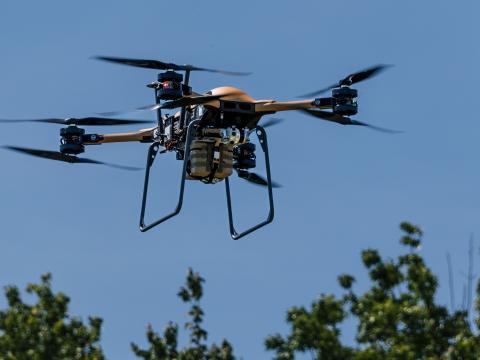Training, Not Technology, Is Key to Urban Warfare
Hard-fought lessons learned around the world are changing the way Marines plan to fight in cities.
The U.S. Marine Corps is working a new combined arms team approach to address the challenges posed by fighting in an urban environment. This focus emphasizes training Marines to fight in a new mix of armor and infantry that support each other without sacrificing maneuver warfare capabilities.
Instead of solving urban warfare challenges by incorporating exotic new technologies, the Marines are focusing on a few core configurations whose personnel would be instructed in urban conflict. Forces would move in small groups to create a three-dimensional security area clear of adversaries. They would operate to counter tactics similar to those employed by guerillas in recent conflicts in Chechnya (SIGNAL, May 2000, page 39).
While not emphasizing new technologies, these efforts do not eschew them, however. Command and control of individuals inside buildings may require personal communications systems networked with squad leaders. New weapons and vehicles must be designed and incorporated to allow forces to move quickly without sacrificing cover. And, some of the weapons that could be used by potential adversaries would require defensive measures that remain to be invented.
The focal point of this effort is the Marine Corps’ Project Metropolis. It evolved from the Marine Corps Urban Warrior experimentation, which dealt mostly with technologies and structural changes. A key result emerging from those experiments was the importance of tactics, techniques and procedures, relates Capt. Tyler Bush, USMC, operations officer for Project Metropolis.
The first Project Metropolis phase involved a series of mid- to high-intensity conflict experiments starting at platoon to company and finishing at the battalion combined arms level. The current focus is on peacekeeping operations.
Results gleaned from the first phase spawned a comprehensive basic urban skills training curriculum that ranges from the individual Marine to the company combined arms level. Capt. Ron Storer, USMC, training officer in charge of Project Metropolis, explains that this urban warfare combined arms company comprises a company of infantry, a platoon of tanks, a platoon of amphibious assault vehicles and a platoon of light amphibious vehicles (LAVs) and organic infantry weapon systems such as mortars and combined arms antitank teams.
Training at the individual level focuses on movement, assault, forcible entry, patrol and countersniper operations. Once the Marine experiences the core requirement training, he learns how to deploy the organic weapon systems in the urban environment.
Capt. Storer explains that this training includes lessons learned from the experiences of both sides in Chechnya as well as from U.S. lessons in Somalia and in Hue, Vietnam. This comprehensive curriculum currently is being reviewed by the Marine Corps Training and Education Command for formal implementation into Marine Corps training.
Foremost among findings is possible threat definition. Capt. Storer relates that the threat likely will be asymmetrical, probably taking the form of six-person hunter-killer teams roaming through a city. These small teams would feature decentralized command and control, but they would have the capability to mass where necessary. An example the captain notes is that the Chechens’ rules of engagement appeared to be simply to kill Russians.
One significant lesson is that infantry cannot fight alone in an urban environment, Capt. Bush declares. The Marines’ urban warfare combined arms teams are designed for optimum performance in that environment.
These teams differ from conventional Marine combined arms teams. The urban warfare teams eschew elements such as air support or long-range artillery in favor of a direct fire combined arms fight. The infantry squad leader has some control over more powerful direct fire weapon systems, such as tanks or LAVs, to support his assault or to suppress an enemy. Instead of leveling a city with long-range artillery bombardments—as the Russians did with Grozny in Chechnya—the U.S. Marine forces would apply specific fire to local targets.
For example, an infantry fire team may be attached to a tank and may utilize one maneuver element within a squad. Instead of having to maneuver three fire teams and a tank, the squad leader would have one tank team and two fire teams. This way, the squad leader would not have to exceed three elements of maneuver, Capt. Storer explains.
If the urban conflict were to change from guerilla activity to a frontal assault by an opposing army, the Marine urban warfare units still would be able to respond appropriately. They would not be abandoning their existing capabilities in their new urban configurations. If needed, other assets such as helicopters and attack aircraft can be deployed quickly.
“The hardest thing in an urban environment is finding the enemy,” Capt. Storer says. “The urban combined arms teams have the flexibility to maneuver firepower to flank, envelop and destroy an enemy.” This approach would apply to a standard army, even one that is dug in, as well, he adds. Maneuver warfare concepts are still applicable to the urban warfare environment.
Maintaining security in the urban environment will require a new approach. Instead of the linear security common to conventional land operations, urban warriors will have to practice spherical security. Capt. Storer explains that forces moving in an urban environment no longer have the luxury of a rear area. This requires a “tactical bubble” within which all friendly forces are a part of security.
The urban combined arms team lends itself well to this spherical bubble, he continues. The configuration can maneuver abruptly when confronted by a new and different threat, and it can maintain the bubble throughout its operations. Resupply units can bring in their own security bubble as they move into the area of operations.
This approach also solves the problem of securing a building during an urban operation. Controlling a two-story building half a block in length could require an entire company. When forces are able to destroy the enemy entirely, it can leave an empty building devoid of threats.
Capt. Storer, an armor officer, relates that another significant change is that tanks can operate individually. However, support always is present—either from another vehicle or from an infantry team. Chechnya taught that both infantry and tanks need support from each other, he emphasizes.
In their second Chechnya invasion, Russian forces dealt with the three-dimensional challenge posed by buildings by leveling Grozny to a two-dimensional state. Not only is this approach not the Marine Corps’ standard operating procedure, but also reducing a city to rubble severely limits maneuverability. In addition, the asymmetrical enemy’s six-man hunter-killer teams can operate very effectively amid the rubble.
The emphasis on training over technology has not eliminated the Marines’ hardware wish list, however. Maintaining these urban warfare teams will require some new equipment, and the two captains express the need for advanced technologies to help improve Marines’ chances of success.
Marines clearing a building room by room will require more individualized communications systems to take the place of voice and hand signals. The intrasquad communication radio system can permit team leaders to talk to their squad leaders. Capt. Bush describes it as a commercial off-the-shelf radio adapted to military spectrum use, although it is not encrypted. This radio is being used for more than it originally was designed.
The current need is to fill the communications gap between the squad leader and the platoon commander. Different options are under consideration, including the Racal multiband inter/intra team radio (MBITR) multispectral radio. The optimum system for a rifleman would have a push-to-talk capability that does not require that he move his hands far from his weapon. This might encompass a chest-mounted button or even a wireless one attached to the rifle. Capt. Bush notes that a potential drawback to a wireless push-to-talk button would be the possibility of it activating a system worn by another nearby Marine. However, this hands-free radio capability would be a boon to urban warriors.
Capt. Storer adds that this small radio should have the capability of being plugged into a tank’s communications system so that the vehicle’s commander does not have to wear another headset under his helmet.
Capt. Bush allows that extending communications connectivity to the individual Marine will require considerable training. Adding a separate network, and with it new radio procedures, could tax resources and create confusion. A typical configuration might consist of a platoon commander/squad leader network and a squad network that equips each individual.
Capt. Storer relates that units involved in urban environment training for more than four weeks begin to economize their communications. Instead of constantly issuing radio requests for information, most Marines would end up listening to the communications traffic among squad and fire team leaders to glean situational awareness. Once the novelty of networked communications wore off, the Marines would use the radio system as intended with a maximum level of proficiency.
Increased communications bring increased security requirements. Encryption for individual communications probably is not necessary because most of these transmissions involve local situational awareness. An enemy would have to understand code words and unit standard operational procedures completely to be able to exploit any eavesdropping. Also, squads tend to deal in perishable information that does not hold any value for long.
Other equipment needs reflect the requirements of room-to-room searches. Capt. Bush sites a manportable breacher’s kit as an essential piece of gear for urban warriors. This kit contains a sledge hammer, a hooligan tool, a flatbar and a crowbar.
Another useful item is a telescoping ladder. The captain continues that the Marines are experimenting with a ladder that can reach second-story windows, yet telescopes down to about 2.5 feet high. While small enough for one man to carry, this ladder weighs about 30 pounds, which may limit its use somewhat.
The Marines also are considering equipping their forces with a small urbanized logistics vehicle. This might be a small off-road vehicle similar to the John Deere Gator, a version of which is used by the U.S. Army, for example. The ideal vehicle would be four-wheeled and could be hidden easily, maneuver in a tight area, traverse rough terrain and tow a trailer that could be used for evacuating casualties rapidly.
One urban warrior need is for standoff breaching equipment. Currently, Marines can place explosives against a wall to create a man-sized hole, but this risks exposing the man to enemy fire. A high-explosive shell fired against the wall could create a pile of rubble instead of a relatively clean access hole. A 50-caliber machine gun can etch out a hole, but at the expense of valuable ammunition. The Corps would like a device that can punch a hole in a wall from across a street or from a nearby room without requiring the Marine to lose his concealment.
Defense against likely urban weaponry may be complicated by new systems brought to bear by adversaries. Russian forces in Grozny used the RPO-A Shmel weapon system effectively, and Capt. Bush describes it as a considerable threat. The thermobaric weapon can wreak destruction in a host of different settings, and no effective defensive measure currently exists. Helmets and personal armor, for example, actually may amplify the Shmel’s effects. A Marine may survive the initial explosion only to die hours later from internal injuries caused by the effects of the overpressure.
Even the training can benefit from new equipment. Capt. Bush notes that Marines currently employ simunitions, which are a cross between blanks and paintballs. They are fired out of a small arms weapon just like a bullet, and they strike with the same impact as paintballs. However, they are more precise than paintballs, and Marines must wear protective gear when training with them. The captain relates that their range is not long enough to provide a true simulation of a bullet, but they hurt when they strike and provide a Marine with a realistic idea of the hazards of enemy fire in close combat. The Corps uses paintballs in place of grenades and mortars, and researchers are looking to enable the M-249 squad automatic weapon (SAW) to use paintballs.


Comments